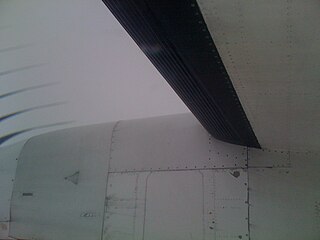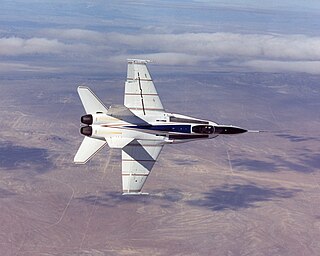Aeroelasticity is the branch of physics and engineering that studies the interactions between the inertial, elastic, and aerodynamic forces that occur when an elastic body is exposed to a fluid flow. Although historical studies have been focused on aeronautical applications, recent research has found applications in fields such as energy harvesting and understanding snoring. The study of aeroelasticity may be broadly classified into two fields: static aeroelasticity, which deals with the static or steady response of an elastic body to a fluid flow; and dynamic aeroelasticity, which deals with the body's dynamic response. Aeroelasticity draws on the study of fluid mechanics, solid mechanics, structural dynamics and dynamical systems. The synthesis of aeroelasticity with thermodynamics is known as aerothermoelasticity, and its synthesis with control theory is known as aeroservoelasticity.

In fluid dynamics, a stall is a reduction in the lift coefficient generated by a foil as angle of attack increases. This occurs when the critical angle of attack of the foil is exceeded. The critical angle of attack is typically about 15 degrees, but it may vary significantly depending on the fluid, foil, and Reynolds number.

A leading-edge extension (LEX) is a small extension to an aircraft wing surface, forward of the leading edge. The primary reason for adding an extension is to improve the airflow at high angles of attack and low airspeeds, to improve handling and delay the stall. A dog tooth can also improve airflow and reduce drag at higher speeds.

A thermostat is a component which senses the temperature of a physical system and performs actions so that the system's temperature is maintained near a desired setpoint.

An airfoil or aerofoil is the cross-sectional shape of a wing, blade, or sail.

The X-43 was an experimental unmanned hypersonic aircraft with multiple planned scale variations meant to test various aspects of hypersonic flight. It was part of the X-plane series and specifically of NASA's Hyper-X program. It set several airspeed records for jet aircraft. The X-43 is the fastest aircraft on record at approximately Mach 9.6.

The Grumman X-29 was an American experimental aircraft that tested a forward-swept wing, canard control surfaces, and other novel aircraft technologies. The X-29 was developed by Grumman, and the two built were flown by NASA and the United States Air Force. The aerodynamic instability of the X-29's airframe required the use of computerized fly-by-wire control. Composite materials were used to control the aeroelastic divergent twisting experienced by forward-swept wings, and to reduce weight. The aircraft first flew in 1984, and two X-29s were flight tested through 1991.
Bleed air produced by gas turbine engines is compressed air that is taken from the compressor stage of those engines, which is upstream of the fuel-burning sections. In modern airliner engines, two regulator valves turn on and off automatically and are controlled by at least "...two air supply and cabin pressure controllers (ASCPCs) which open and close appropriate valves. Engine bleed air comes from the high stage or low stage engine compressor section. Low stage air is used during high power setting operation, and high stage air is used during descent and other low power setting operations." Bleed air from that system can be utilized for internal cooling of the engine, cross-starting another engine, engine and airframe anti-icing, cabin pressurization, pneumatic actuators, air-driven motors, pressurizing the hydraulic reservoir, and waste and water storage tanks. Some engine maintenance manuals refer to such systems as "customer bleed air". Bleed air is valuable in an aircraft for two properties: high temperature and high pressure.

Flaps are a kind of high-lift device used to increase the lift of an aircraft wing at a given airspeed. Flaps are usually mounted on the wing trailing edges of a fixed-wing aircraft. Flaps are used for extra lift on takeoff. Flaps also cause an increase in drag in mid-flight, so they are retracted when not needed.

De-icing is the process of removing snow, ice or frost from a surface. Anti-icing is understood to be the application of chemicals that not only de-ice but also remain on a surface and continue to delay the reformation of ice for a certain period of time, or prevent adhesion of ice to make mechanical removal easier.

USAir Flight 405 was a regularly scheduled domestic passenger flight between LaGuardia Airport in Queens, New York City, New York, and Cleveland, Ohio. On March 22, 1992, a USAir Fokker F28, registration N485US, flying the route, crashed in poor weather in a partially inverted position in Flushing Bay, shortly after liftoff from LaGuardia. The undercarriage lifted off from the runway; however, the airplane failed to gain lift, flying only several meters above the ground. The aircraft then veered off the runway and hit multiple obstructions before coming to rest in Flushing Bay, just beyond the end of the runway. Of the 51 people on board, 27 were killed, including the captain and a member of the cabin crew.

A supercritical airfoil is an airfoil designed primarily to delay the onset of wave drag in the transonic speed range. Supercritical airfoils are characterized by their flattened upper surface, highly cambered ("downward-curved") aft section, and larger leading-edge radius compared with NACA 6-series laminar airfoil shapes. Standard wing shapes are designed to create lower pressure over the top of the wing. The camber of the wing determines how much the air accelerates around the wing. As the speed of the aircraft approaches the speed of sound, the air accelerating around the wing reaches Mach 1 and shockwaves begin to form. The formation of these shockwaves causes wave drag. Supercritical airfoils are designed to minimize this effect by flattening the upper surface of the wing.

The Space Shuttle thermal protection system (TPS) is the barrier that protected the Space Shuttle Orbiter during the searing 1,650 °C (3,000 °F) heat of atmospheric reentry. A secondary goal was to protect from the heat and cold of space while in orbit.
This is an alphabetical list of articles pertaining specifically to aerospace engineering. For a broad overview of engineering, see List of engineering topics. For biographies, see List of engineers.
In aviation, icing conditions are those atmospheric conditions that can lead to the formation of water ice on the surfaces of an aircraft, or within the engine as carburetor icing. Inlet icing is another engine-related danger, often occurring in jet aircraft. These icing phenomena do not necessarily occur together. Many aircraft, especially general aviation aircraft, are not certified for flight into known icing—icing conditions certain or likely to exist, based on pilot reports, observations, and forecasts.

A deicing boot is a type of ice protection system installed on aircraft surfaces to permit a mechanical deicing in flight. Such boots are generally installed on the leading edges of wings and control surfaces as these areas are most likely to accumulate ice and any contamination could severely affect the aircraft's performance.

The X-53 Active Aeroelastic Wing (AAW) development program is a completed American research project that was undertaken jointly by the Air Force Research Laboratory (AFRL), Boeing Phantom Works and NASA's Dryden Flight Research Center, where the technology was flight tested on a modified McDonnell Douglas F/A-18 Hornet. Active Aeroelastic Wing Technology is a technology that integrates wing aerodynamics, controls, and structure to harness and control wing aeroelastic twist at high speeds and dynamic pressures. By using multiple leading and trailing edge controls like "aerodynamic tabs", subtle amounts of aeroelastic twist can be controlled to provide large amounts of wing control power, while minimizing maneuver air loads at high wing strain conditions or aerodynamic drag at low wing strain conditions. The flight program which first proved the use of AAW technology in full scale was the X-53 Active Aeroelastic Wing program.
ATA 100 contains the reference to the ATA numbering system which is a common referencing standard for commercial aircraft documentation. This commonality permits greater ease of learning and understanding for pilots, aircraft maintenance technicians, and engineers alike. The standard numbering system was published by the Air Transport Association on June 1, 1956. While the ATA 100 numbering system has been superseded, it continued to be widely used until it went out of date back in 2015, especially in documentation for general aviation aircraft, on aircraft Fault Messages and the electronic and printed manuals.
Most of the terms listed in Wikipedia glossaries are already defined and explained within Wikipedia itself. However, glossaries like this one are useful for looking up, comparing and reviewing large numbers of terms together. You can help enhance this page by adding new terms or writing definitions for existing ones.

















